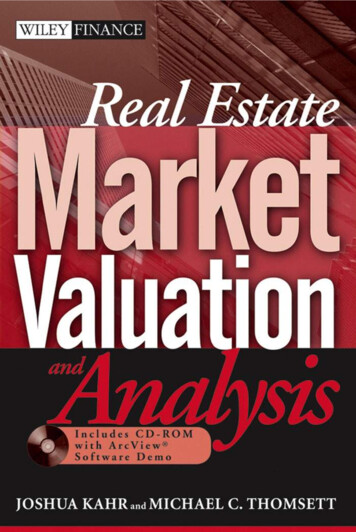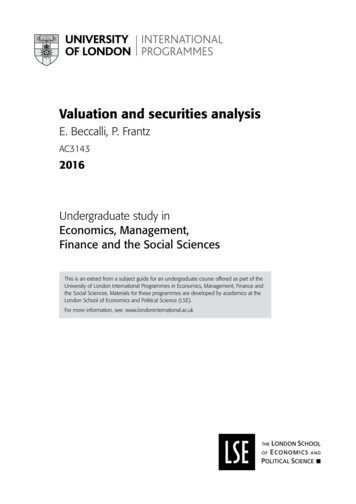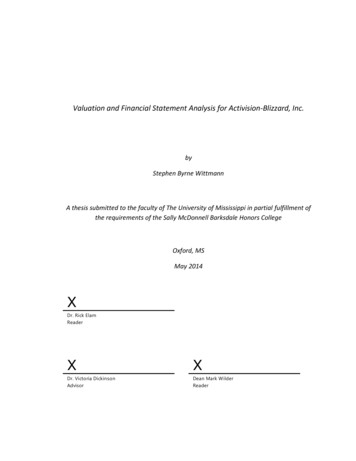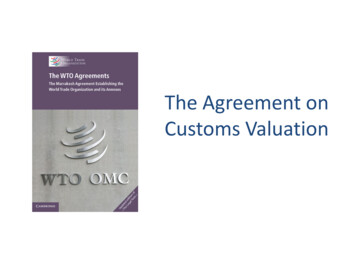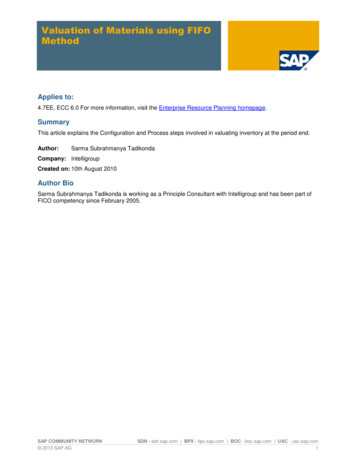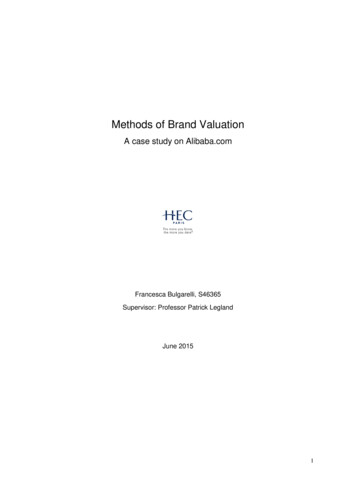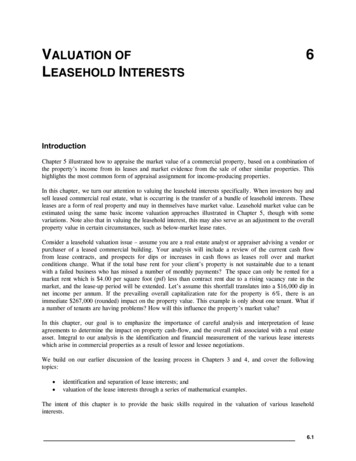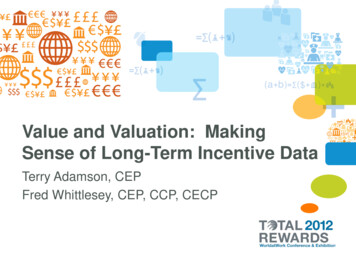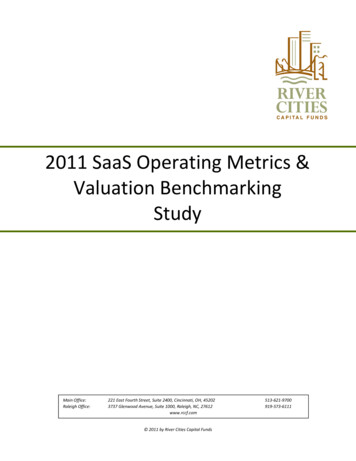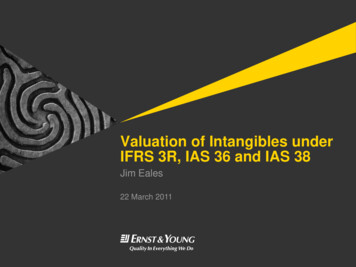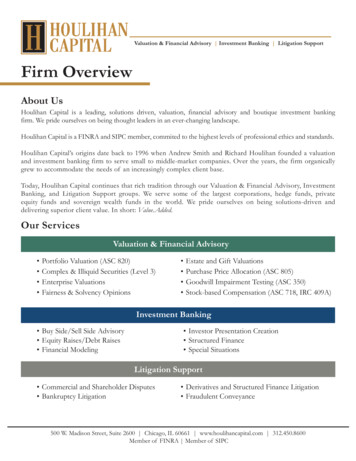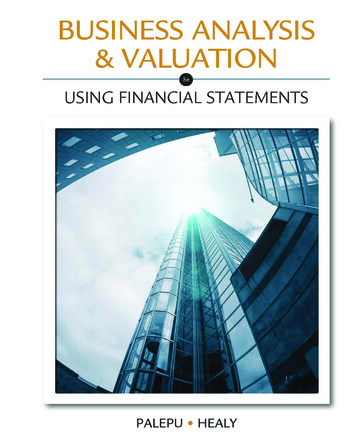
Transcription
BUSINESS ANALYSIS& VALUATIONUSING FINANCIAL STATEMENTSCopyright 2012 Cengage Learning. All Rights Reserved. May not be copied, scanned, or duplicated, in whole or in part. Due to electronic rights, some third party content may be suppressed from the eBook and/or eChapter(s).Editorial review has deemed that any suppressed content does not materially affect the overall learning experience. Cengage Learning reserves the right to remove additional content at any time if subsequent rights restrictions require it.
Copyright 2012 Cengage Learning. All Rights Reserved. May not be copied, scanned, or duplicated, in whole or in part. Due to electronic rights, some third party content may be suppressed from the eBook and/or eChapter(s).Editorial review has deemed that any suppressed content does not materially affect the overall learning experience. Cengage Learning reserves the right to remove additional content at any time if subsequent rights restrictions require it.
BUSINESS ANALYSIS& VALUATIONUSING FINANCIAL STATEMENTS5eKRISHNA G. PALEPU, PhDRoss Graham Walker Professor of Business AdministrationHarvard UniversityPAUL M. HEALY, PhD, ACAJames R. Williston Professor of Business AdministrationHarvard UniversityAustralia Brazil Japan Korea Mexico Singapore Spain United Kingdom United StatesCopyright 2012 Cengage Learning. All Rights Reserved. May not be copied, scanned, or duplicated, in whole or in part. Due to electronic rights, some third party content may be suppressed from the eBook and/or eChapter(s).Editorial review has deemed that any suppressed content does not materially affect the overall learning experience. Cengage Learning reserves the right to remove additional content at any time if subsequent rights restrictions require it.
This is an electronic version of the print textbook. Due to electronic rights restrictions,some third party content may be suppressed. Editorial review has deemed that any suppressedcontent does not materially affect the overall learning experience. The publisher reserves the rightto remove content from this title at any time if subsequent rights restrictions require it. Forvaluable information on pricing, previous editions, changes to current editions, and alternateformats, please visit www.cengage.com/highered to search by ISBN#, author, title, or keyword formaterials in your areas of interest.Copyright 2012 Cengage Learning. All Rights Reserved. May not be copied, scanned, or duplicated, in whole or in part. Due to electronic rights, some third party content may be suppressed from the eBook and/or eChapter(s).Editorial review has deemed that any suppressed content does not materially affect the overall learning experience. Cengage Learning reserves the right to remove additional content at any time if subsequent rights restrictions require it.
Business Analysis & Valuation: UsingFinancial Statements, 5th editionKrishna G. Palepu and Paul M. HealySenior Vice President, LRS/Acquisitions &Solutions Planning: Jack W. CalhounEditor-in-Chief: Rob DeweySenior Acquisitions Editor: Matt Filimonov 2013, 2008 South-Western, Cengage Learning.ALL RIGHTS RESERVED. No part of this work covered by the copyrightherein may be reproduced, transmitted, stored, or used in any form or byany means graphic, electronic, or mechanical, including but not limitedto photocopying, recording, scanning, digitizing, taping, web distribution,information networks, or information storage and retrieval systems,except as permitted under Section 107 or 108 of the 1976 United StatesCopyright Act, without the prior written permission of the publisher.Senior Developmental Editor: Craig AveryEditorial Assistant: A. J. SmileySenior Market Development Manager:Natalie LivingstonSenior Brand Manager: Kristen HurdMarketing Manager: Heather MooneyFor product information and technology assistance, contact us atCengage Learning Customer & Sales Support, 1-800-354-9706For permission to use material from this text or product, submit allrequests online at www.cengage.com/permissions.Further permissions questions can be emailed topermissionrequest@cengage.comMarketing Communications Manager:Sarah GreberLibrary of Congress Control Number: 2012948788Marketing Coordinator: Eileen CorcoranStudent Edition ISBN 13: 978-1-111-97230-1Senior Art Director: Stacy ShirleyStudent Edition ISBN 10: 1-111-97230-3Production Management, Internal Design,and Composition: PreMediaGlobalStudent Edition with CD ISBN 13: 978-1-285-42618-1Media Editor: Bryan EnglandStudent Edition with CD ISBN 10: 1-285-42618-5Rights Acquisition Director: AudreyPettengillRights Acquisition Specialist, Text andImage: Audrey PettengillSenior Manufacturing Planner: Doug WilkeSouth-Western5191 Natorp BoulevardMason, OH 45040USACover Designer: Red Hangar DesignCover Image(s): iStock Photo/franckreporterCengage Learning is a leading provider of customized learning solutions with office locations around the globe, including Singapore, theUnited Kingdom, Australia, Mexico, Brazil, and Japan. Locate your localoffice at: www.cengage.com/globalCengage Learning products are represented in Canada byNelson Education, Ltd.For your course and learning solutions, visit www.cengage.comPurchase any of our products at your local college store or at ourpreferred online store www.cengagebrain.com.Printed in the United States of America1 2 3 4 5 6 7 16 15 14 13 12Copyright 2012 Cengage Learning. All Rights Reserved. May not be copied, scanned, or duplicated, in whole or in part. Due to electronic rights, some third party content may be suppressed from the eBook and/or eChapter(s).Editorial review has deemed that any suppressed content does not materially affect the overall learning experience. Cengage Learning reserves the right to remove additional content at any time if subsequent rights restrictions require it.
PREFACEFinancial statements are the basis for a wide range of business analysis. Managersuse them to monitor and judge their firms’ performance relative to competitors,to communicate with external investors, to help judge what financial policies theyshould pursue, and to evaluate potential new businesses to acquire as part of their investment strategy. Securities analysts use financial statements to rate and value companiesthey recommend to clients. Bankers use them in deciding whether to extend a loan to aclient and to determine the terms of the loan. Investment bankers use them as a basis forvaluing and analyzing prospective buyouts, mergers, and acquisitions. And consultantsuse them as a basis for competitive analysis for their clients.Not surprisingly, therefore, we find that there is a strong demand among business students for a course that provides a framework for using financial statement data in a variety of business analysis and valuation contexts. The purpose of this book is to providesuch a framework for business students and practitioners. The first four editions of thisbook have succeeded far beyond our expectations in equipping readers with this usefulframework, and the book has gained proponents in accounting and finance departmentsin business schools in the United States and around the world.CHANGES FROM THE FOURTH EDITIONIn response to suggestions and comments from colleagues, students, and reviewers, wehave incorporated the following changes in the fifth edition: Data, analyses, and issues have been thoroughly updated. Where appropriate, lessons have been drawn from current events such as theglobal financial crisis of 2008 and the ongoing European debt crisis. The financial analysis and valuation chapters (Chapters 6–8) have been updatedwith a focus on firms in the U.S. retail department store sector, primarily TJX andNordstrom. In addition, we have provided a more cohesive overall discussion ofthe four key components of effective financial statement analysis that this bookexamines by introducing these companies in our discussion of strategy analysisin Chapter 2 and staying with them through the accounting, financial, andprospective analyses that follow. We have provided a greatly expanded examination of the impact of accountingadjustments (introduced in Chapter 4) on company analysis by analyzing bothunadjusted and adjusted financial ratio and cash flow measures for TJX andNordstrom in Chapter 5, and by then using adjusted numbers for TJX in theprospective analysis of Chapters 6–8. The topic of U.S. GAAP/IFRS convergence is introduced and examined, withdiscussion and examples in comparing companies reporting under U.S. GAAP andIFRS, and a brief discussion on important remaining differences between U.S.GAAP and IFRS. An expanded discussion of fair value accounting is included, given its increasinguse globally and also its much discussed role in the 2008 financial crisis. We have streamlined and greatly enhanced the readability of the discussion on thetheory behind valuation techniques in Chapters 7 and 8. In our Text and Cases edition, we have included new and updated HarvardBusiness School cases. In all, we include 27 cases in this edition.vCopyright 2012 Cengage Learning. All Rights Reserved. May not be copied, scanned, or duplicated, in whole or in part. Due to electronic rights, some third party content may be suppressed from the eBook and/or eChapter(s).Editorial review has deemed that any suppressed content does not materially affect the overall learning experience. Cengage Learning reserves the right to remove additional content at any time if subsequent rights restrictions require it.
viPreface We are introducing with this edition an online version of the BAV modeling tool,which represents a significant enhancement of the tool over the previousspreadsheet-based version. This comprehensive modeling tool implements theanalytical framework and techniques discussed in this book, and allows students toeasily import the financial statements of a company into the model from threemajor data providers—Thomson ONE, Capital IQ, and the Compustat database ofthe Wharton Research Data Services—as well as to import manually created statements. A user-friendly interface allows the analyst to navigate through the toolwith ease. The tool facilitates the following activities: (1) recasting the reportedfinancial statements in a standard format for analysis; (2) performing accountinganalysis as discussed in Chapters 3 and 4, making desired accounting adjustments,and producing restated financials; (3) computing ratios and free cash flows aspresented in Chapter 5; (4) producing forecasted income, balance sheet, and cashflow statements for as many as 15 years into the future using the approach discussed in Chapter 6; (5) preparing a terminal value forecast using the abnormalearnings, the abnormal returns, and discounted cash flow methods as discussed inChapters 7 and 8; and (6) valuing a company (either assets or equity) from theseforecasts as also discussed in Chapters 7 and 8. We have seen that the BAVmodeling tool can make it significantly easier for students to apply the frameworkand techniques discussed in the book in a real-world context, and we feel that thenew online version, with its enhanced data import flexibility and improved overallinterface, further enhances the usability and usefulness of this tool.KEY FEATURESThis book differs from other texts in business and financial analysis in a number ofimportant ways. We introduce and develop a four-part framework for business analysisand valuation using financial statement data. We then show how this framework can beapplied to a variety of decision contexts.Framework for AnalysisWe begin the book with a discussion of the role of accounting information andintermediaries in the economy, and how financial analysis can create value in wellfunctioning markets (Chapter 1). We identify four key components, or steps, of effectivefinancial statement analysis: Business strategy analysisAccounting analysisFinancial analysisProspective analysisThe first step, business strategy analysis (Chapter 2), involves developing an understanding of the business and competitive strategy of the firm being analyzed. Incorporating business strategy into financial statement analysis is one of the distinctive features ofthis book. Traditionally, this step has been ignored by other financial statement analysisbooks. However, we believe that it is critical to begin financial statement analysis with acompany’s strategy because it provides an important foundation for the subsequent analysis. The strategy analysis section discusses contemporary tools for analyzing a company’s industry, its competitive position and sustainability within an industry, and thecompany’s corporate strategy.Copyright 2012 Cengage Learning. All Rights Reserved. May not be copied, scanned, or duplicated, in whole or in part. Due to electronic rights, some third party content may be suppressed from the eBook and/or eChapter(s).Editorial review has deemed that any suppressed content does not materially affect the overall learning experience. Cengage Learning reserves the right to remove additional content at any time if subsequent rights restrictions require it.
PrefaceviiAccounting analysis (Chapters 3 and 4) involves examining how accounting rulesand conventions represent a firm’s business economics and strategy in its financial statements, and, if necessary, developing adjusted accounting measures of performance. Inthe accounting analysis section, we do not emphasize accounting rules. Instead wedevelop general approaches to analyzing assets, liabilities, entities, revenues, andexpenses. We believe that such an approach enables students to effectively evaluate acompany’s accounting choices and accrual estimates, even if they have only a basicknowledge of accounting rules and standards. The material is also designed to allow students to make accounting adjustments rather than merely identify questionable accounting practices.Financial analysis (Chapter 5) involves analyzing financial ratio and cash flow measures of the operating, financing, and investing performance of a company relative toeither key competitors or historical performance. Our distinctive approach focuses onusing financial analysis to evaluate the effectiveness of a company’s strategy and tomake sound financial forecasts.Finally, in prospective analysis (Chapters 6–8) we show how to develop forecastedfinancial statements and how to use these to make estimates of a firm’s value. Our discussion of valuation includes traditional discounted cash flow models as well as techniques that link value directly to accounting numbers. In discussing accounting-basedvaluation models, we integrate the latest academic research with traditional approachessuch as earnings and book value multiples that are widely used in practice.Although we cover all four steps of business analysis and valuation in the book, werecognize that the extent of their use depends on the user’s decision context. For example, bankers are likely to use business strategy analysis, accounting analysis, financialanalysis, and the forecasting portion of prospective analysis. They are less likely to beinterested in formally valuing a prospective client.Application of the Framework to Decision ContextsThe next section of the book shows how our business analysis and valuation frameworkcan be applied to a variety of decision contexts: Equity securities analysis (Chapter 9)Credit analysis and distress prediction (Chapter 10)Merger and acquisition analysis (Chapter 11)Communication and governance (Chapter 12)For each of these topics we present an overview to provide a foundation for the classdiscussions. Where possible we bring in relevant real-world scenarios and institutionaldetails, and also examine the results of academic research that are useful in applyingthe analysis concepts developed earlier in the book. For example, the chapter on creditanalysis shows how banks and rating agencies use financial statement data to developanalyses for lending decisions and to rate public debt issues. This chapter also presentsacademic research on how to determine whether a company is financially distressed.USING THE BOOKWe designed the book so that it is flexible for courses in financial statement analysis fora variety of student audiences—MBA students, master’s in accounting students, executiveprogram participants, and undergraduates in accounting or finance. Depending upon theaudience, the instructor can vary the manner in which the conceptual materials inthe chapters and end-of-chapter questions are used. To get the most out of the book,Copyright 2012 Cengage Learning. All Rights Reserved. May not be copied, scanned, or duplicated, in whole or in part. Due to electronic rights, some third party content may be suppressed from the eBook and/or eChapter(s).Editorial review has deemed that any suppressed content does not materially affect the overall learning experience. Cengage Learning reserves the right to remove additional content at any time if subsequent rights restrictions require it.
viiiPrefacestudents should have completed basic courses in financial accounting, finance, and eitherbusiness strategy or business economics. The text provides a concise overview of some ofthese topics. But it would probably be difficult for students with no prior knowledge inthese fields to use the chapters as stand-alone coverage of them.If the book is used for students with prior working experience or for executives, theinstructor can use almost a pure case approach, adding relevant lecture sections asneeded. When teaching students with little work experience, a lecture class can be presented first, followed by an appropriate case or other assignment material. Alternatively,lectures can be used as a follow-up to cases to more clearly lay out the conceptual issuesraised in the case discussions. This may be appropriate when the book is used in undergraduate capstone courses. In such a context, cases can be used in course projects thatcan be assigned to student teams.ACKNOWLEDGMENTSThe first edition of this book was co-authored with our colleague and friend, VictorBernard. Vic was the Price Waterhouse Professor of Accounting and Director of thePaton Accounting Center at the University of Michigan. He passed away unexpectedly onNovember 14, 1995. While we no longer list Vic as a co-author, we wish to acknowledgehis enduring contributions to our own views on financial analysis and valuation, and to theideas reflected in this book.We also wish to thank Scott Renner for his tireless research assistance in the revisionof the text chapters and in refining the online BAV model; Trenholm Ninestein of theHBS Information Technology Group for his help in the development of the onlineBAV model; Chris Allen and Kathleen Ryan of HBS Knowledge and Library Servicesfor assistance with data on financial ratios for U.S. companies; the Division of Researchat the Harvard Business School for assistance in developing materials for this book; andour past and present MBA students for stimulating our thinking and challenging us tocontinually improve our ideas and presentation.We especially thank the following colleagues who gave us feedback as we wrote thisedition: Patricia Beckenholdt, University of Maryland University College; Timothy P.Dimond, Northern Illinois University; Jocelyn Kauffunger, University of Pittsburgh;Suneel Maheshwari, Marshall University; K. K. Raman, University of North Texas; LoriSmith, University of Southern California; Vic Stanton, University of California, Berkeley;Charles Wasley, University of Rochester.We are also very grateful to Laurie Palepu and Deborah Marlino for their helpand assistance throughout this project. Special gratitude goes to Rob Dewey and MattFilimonov for their publishing leadership on this edition, to our colleagues, and toCraig Avery and Heather Mooney at Cengage and Kalpana Venkatramani, projectmanager at
† Prospective analysis The first step, business strategy analysis (Chapter 2), involves developing an under-standing of the business and competitive strategy of the firm being analyzed. Incorporat-ing business strategy into financial statement analysis
